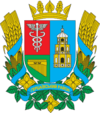Hertsa Raion
| Hertsa Raion Герцаївський район (Ukrainian) Raionul Herța (Romanian) | |||
|---|---|---|---|
| Raion | |||
| |||
 | |||
| Country |
| ||
| Region | Chernivtsi Oblast | ||
| Established | pre-1962, 1991 | ||
| Admin. center | Hertsa | ||
| Subdivisions |
List
| ||
| Government | |||
| • Governor | Vasyl' Mykhailovych Skrypa | ||
| Area | |||
| • Total | 308.7 km2 (119.2 sq mi) | ||
| Population | |||
| • Total | 32,300 | ||
| • Density | 100/km2 (270/sq mi) | ||
| Time zone | EET (UTC+2) | ||
| • Summer (DST) | EEST (UTC+3) | ||
| Postal index | N/A | ||
| Area code | 380 | ||
| Website | Official website | ||
Hertsa Raion (Ukrainian: Герцаївський район, translit.: Hertsaiivs'kyi raion; Romanian: Raionul Herța pronounced [raˈjonul ˈhert͡sa]) is an administrative raion (district) in the southern part of Chernivtsi Oblast in western Ukraine, on the Romanian border. The region has an area of 308.7 km² and 32,000 inhabitants, and centers on the city of Hertsa.
History
Hertza region was part of the Principality of Moldavia since its founding in the 14th century and after the union of Moldavia with Wallachia in 1859 it became part of Romania, which gained its formal independence in 1877.
The region was occupied by the Soviet Union in 1940 following the signing of the Molotov-Ribbentrop Pact with Nazi Germany, and was added to the Ukrainian Soviet Socialist Republic. It was recaptured by Romania in 1941 in the course of Axis attack on the Soviet Union in the Second World War, but was recaptured again by the Soviet Army in 1944. The annexation was confirmed by the Paris Peace Treaties in 1947 between the USSR and the Communist Romania.
The fact that neither the secret protocol (appendix) of the Molotov-Ribbentrop Pact, which specified the expansionist claims of both sides, nor the June 1940 Soviet Ultimatum demanding from Romania the adjacent territory of Northern Bukovina and Bessarabia included Hertsa makes the capture by the Soviets especially controversial. Furthermore, unlike Bessarabia and Northern Bukovina, the region had not been a part of Imperial Russia or Austria-Hungary before World War I, but had been a part of Romania and one of its predecessor states, Moldavia, before that.
In 1962, the region was merged into the Hlybotskyi Raion, and in 1991, was reinstated again.
Demographics
In 1930, the region had a population of 30,082, of which 27,919 (92.8%) Romanians, 1,931 (6.4%) Jews and 232 (0.8%) people of other ethnicities.
In 2001, the population of Hertsaivskyi Raion was 32,316, of which 91.4% Romanians, 5.0% Ukrainians, 2.3% Moldovans, 0.9% Russians and 0.3% of other ethnicities (see: Ukrainian Census, 2001).
.png)
Localities
Hertsaivskyi Raion is composed of 1 city and 13 incorporated localities, containing a total of 24 villages (Romanian names listed in brackets):
- Герца Hertsa (Herţa)
- Байраки Bairaky (Mogoșești)
- Буківка Bukіvka (Poieni, Poieni-Bucovina, Puieni)
- Годинівка Hodynivka (Godinești, Godânești)
- Горбова Horbova (Horbova)
- Хряцька Khriatska (Hreațca)
- Куликівка Kulykіvka (Colincăuți, Culiceni)
- Лунка Lunka (Lunca)
- Молниця Molnytsia (Molnița)
- Остриця Ostrytsia (Ostrița, Stârcești)
- Петрашівка Petrashіvka (Mihoreni, Petrașivca)
- Тернавка Ternavka (Târnauca)
- Цурень Tsuren (Țureni)
- Велика Буда Velyka Buda (Buda Mare)
The 10 unincorporated villages are:
- Банчени Bancheny (Bănceni)
- Дяківці Diakіvtsі (Probotești)
- Круп'янське Krupianske (Pasat)
- Луковиця Lukovytsia (Lucovița, Lucovița Moldovenească)
- Мала Буда Mala Buda (Buda Mică)
- Маморниця Mamornytsia (Mamornița, Mamornița Ucraineană)
- Могилівка Mohylіvka (Movila)
- Підвальне Pіdval'ne (Becești)
- Радгоспівка Radhospivka (Vama)
- Великосілля Velykosіllia (Pilipăuți, Satul Mare)
See also
External links
- (Ukrainian) Hertsaivskyi Raion - official website
- (Romanian) România Liberă newspaper - book review

